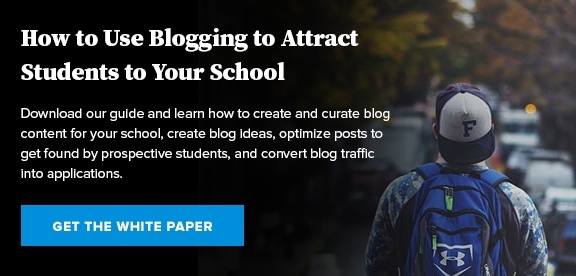A successful digital marketing strategy that attracts prospective students and closes them into applicants and enrolled students requires your marketing team to succeed in social listening and publishing, retargeting, blogging, email marketing, and more. But while social media gets the headlines, blogging remains the key to your marketing success. Think of your marketing as an iceberg. Your social media feeds may showcase the tip of the formation and get everyone’s attention, but the larger, more substantive piece is your blog, below the water’s surface.
Managing a successful blog in higher education, or anywhere for that matter, is no easy task. Higher education blogs in particular are most successful when they have a distinct purpose and continuously feature a diverse set of voices in a consistent way that aligns with a school’s brand. So how can you ensure that your blog meets the challenge? Keep reading to get a head start on creating a higher ed blog your school can be proud of.
Goals
Goals are the first step in any project, but are often overlooked or skipped entirely. And even when goals are created, they frequently take the shape of abstract, idealistic hopes and dreams. But goals, when done right, can bring clarity, focus, and purpose to any project, including your higher ed blog.
For example, instead of:
“The State University blog will showcase our diverse community of students and increase interest in applying to State University.”
Consider:
Alternative 1: “The State University blog will publish content to our prospective and admitted students from the perspective of over 200 guest authors.”
Alternative 2: “The State University blog will drive increased referral traffic to our website admissions pages by 30% in 2017.”
In alternative goal 1, we’ve clearly defined what “diverse community of students” means by specifically expressing a goal of over 200 guest authors. This helps the entire marketing team by making the discovery of new guest authors a priority over asking students to post multiple articles.
In alternative goal 2, we’ve clearly defined what “increase interest in applying” means by setting a measurable target (30% increase) to a specific destination (admissions pages) in a clear time period (2017).
For a blog, goals should be hyper-focused and easy to evaluate. Keep it simple; everyone on your marketing team should know what the goal of the blog is.
Content Calendar
Once you have clarity and purpose for your blog, it’s time to move on to organization. Keeping in mind the strategic intent of your blog, plan and document your article themes, assign blog posts to guest authors, and document when you expect to receive drafts of articles from guest authors and when you expect to publish a given article.
We’ve documented software options for content calendars on this blog before, but whichever option you choose, a good content calendar should include space for targeted draft and publish dates, each blog post’s target audience, and associated calls-to-action for every article.
Guest Author Processes
In higher education, your blog is only as good as your guest authors. Whether you’re relying on students, faculty, staff, or alumni, keeping your content on schedule and of an acceptable level of quality is imperative.
To keep your content on schedule, it’s important to develop a process for communicating with guest authors. How to do that is ultimately up to each school, but here are a few guidelines to get you started:
- Establish avenues for identifying guest authors.
Can guest authors submit article ideas? If so, how and where? Who are the connected staff members in various offices across campus, like student affairs or career services? How will you communicate with those colleagues to identify potential guest authors?
- What is the incentive for guest authors?
Paying for articles is rarely a feasible option for schools, so get creative. Offer them school swag, or coupons to the bookstore. Appeal to their ideals. Remind them of their own college search, and the sources they used for information. Ask them to pay it forward. Offer a recommendation on their Linkedin profile.
- Set the scope for each article with guest authors.
Don’t just ask them to write about a topic; explore the aspects of that topic that are important to your target audience, and collaboratively set a clear direction for the article. Doing so makes it more likely that you receive a draft that’s what you wanted, and makes it easier for the guest author to write.
- Set a follow-up schedule that works for both parties.
It’s not feasible to follow up with a guest author every day, but you and your guest authors may find it helpful if you connect one week before a first draft is due to see what the progress is on a post and address any issues that may have arisen.
- Establish preferred channels of communication.
Students may want to be followed up with via text, while faculty may prefer phone calls and alumni email communication. Don’t assume that a single form of communication works for everyone because it works for you.
Style Guide
To be clear, a style guide for your blog does not mean a 30-page PDF with detailed rules and sourcing requirements. Rather, your blog should choose an established style guide – consider AP, Chicago, or APA – and then customize that style to your institution. Consider common questions that have come up in the past, or topics relating to the tone of the blog, like:
- Should course titles be capitalized?
- What school acronyms are acceptable to use? Conversely, which acronyms need to be spelled out?
- Are gif’s acceptable on your blog?
- Are contractions acceptable?
A Staff Photographer or High Quality DSLR Camera
We’ve said it again and again on this blog, but visuals matter. A lot. Accordingly, getting high-quality, relevant images for your blog posts is imperative if you want to capture someone’s attention and generate click-throughs.
At 2016’s Confab Higher Ed conference, the majority of attending schools indicated that the marketing team was responsible for sourcing their own images (albeit through a highly unscientific raising of hands). That means that for many marketing teams, a staff photographer is a nothing more than an item on a yearly wish list.
If that situation describes your marketing team though, don’t panic. Prices on prosumer level DSLR cameras have come down considerably in recent years. Concurrently, smartphone cameras have improved considerably. And there are tons of excellent resources out there, like CC Chapman’s “Content Marketing: Photos” course on Lynda.com, to help you take or choose better photos, even if your background isn’t in photography. Another option: your Instagram feed. If your school has a defined hashtag that’s commonly used, source that feed for photos of your campus and repurpose them. Just make sure you get permission from the original source of the photo.
If you’re lucky enough to have a staff photographer at your disposal, share your content calendar with them, and give him or her suggestions on photos when appropriate. And avoid staged photos of the article author. Shoot for candid and environmental photos instead.
There are many crucial components to a successful digital marketing plan, but while new marketing tactics pop up and gain attention, an engaging blog remains at the center of that strategy. If you’re starting a new blog, or just looking to improve the one you have: give it direction and purpose, keep your content organized, and set clear communication processes with your guest authors. And if you’re not sure where to start, give us a shout. We’ve worked with schools large and small on their content strategy and blogging, and would love to have a conversation about your school as well.




